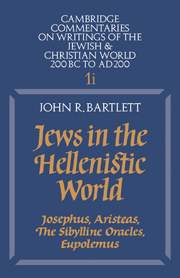THE LETTER OF ARISTEAS
Published online by Cambridge University Press: 08 January 2010
Summary
The Letter of Aristeas is not a letter, in spite of its usual superscription, ‘Aristeas to Philocrates’. Josephus, who paraphrased much of the work, called it ‘the book of Aristaios’, and Eusebius entitled it ‘On the translation of the law of the Jews’. The author himself called his work a discourse; the Greek word diēgēsis is the word used by Luke at the beginning of his gospel to describe the narrative accounts of his predecessors (Luke 1: 1). The author of the Letter uses a number of regular forms and conventions – for example, in his setting the story at a cultured court, in his reference to well-known literary and philosophical people and their ideas, in his description of works of art (51–82), the city of Jerusalem and its surrounding country (100–20), and the banquet at which Ptolemy sought his guests' views on kingship and government (187–299). He ends his work expressing the hope that it will give Ptolemy greater pleasure than the works of the romancers. Whatever his purpose, the author belonged to the hellenistic literary world. He gave himself a Greek name, Aristeas, and, though it is probably a pseudonym, I will use it for convenience when speaking of him.
The purpose of the Letter
The purpose of his discourse is not immediately clear. Aristeas apparently sets out to tell how the Jewish Law was translated into Greek at Alexandria in the reign of Ptolemy Philadelphus (283–246 bc).
- Type
- Chapter
- Information
- Jews in the Hellenistic WorldJosephus, Aristeas, The Sibylline Oracles, Eupolemus, pp. 11 - 34Publisher: Cambridge University PressPrint publication year: 1985



